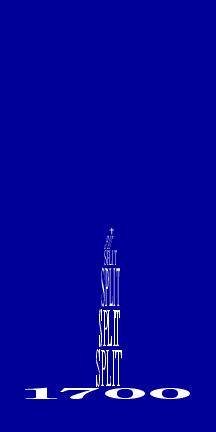
image by Željko Heimer, 11 April 2009

Last modified: 2009-08-15 by dov gutterman
Keywords: croatia | split | dalmatia | splitsko-dalmatinska | split | st. duje | diocletian |
Links: FOTW homepage |
search |
disclaimer and copyright |
write us |
mirrors

image by Željko Heimer, 11 April 2009
See also:
Other Sites:
I located a photo at <www.2mwg.hr>.
Do yo recognize the symbol ? Is it a flag ?
Dov Gutterman, 23 September 1999
Yes, I can identify it. It is the coat of arms of the city of
Split. It is a rectangular "shield" with representation
of the old city - the Diocletian's Palace with characteristic
tower of St. Duje, the patron of the city, which is also
represneted in the sinister shield, while there is the Croatian
chequy shield in dexter. The Croatian chequy is often left
blue-white, but obviously this is not the official policy . The
stone relief with the Coat of Arms is set in the main entrance to
the palace at some time (certainly before 1990, but possibly much
before). also, it may be worth of mentioning that the same Coat
of Arms was used during the socialist period with the fivepointed
red star in place of the Croatian chequy (not in shield form), as
I can prove from some post-cards of 1970's.
However, this coat of arms does not apear on the flag, even if
there is the law enforcing cities to have mono-coloured flags
with coa on it. Possibly, the flag of the city is not officially
adopted after 1990. What they use is blue flag with white
representation of the Palace, somewhat differently artistically
designed the on the coat of arms.
But, lately it seems that only a specific variation of that flag
is used where the white palace is made of word Split repeated
several times and toped with number 1700 -
this being the logo of 1700 years of Split celebration. I have
not been able to get good image of this, though.
Željko Heimer, 24 September 1999
The coat of arms of the city of Split pictures in a
rectangular shield the part of the northern walls of the
Diocletian's palace, as it was in the middle age, and in the
middle above the walls the belfry of the Cathedral. In the upper
corners are two shields, dexter the historical coat of arms of
Croatia and sinister a shield picturing the city patron St.
Dujam. The coat of arms is bordered with the Gothic cheques.
The oldest confirmation that Spilt used the rectangular coat of
arms are dated to the early 14th century. Stonecuttings are
preserved from 14th and 15th century showing the same coat of
arms with the shields around the belfry at any time showed the
central rulers to which Split was paying alliance. Latte the
coats of arms of the city are used also withotu these shields,
and at different times in different artistical shapeing. In 19th
and 20th century the coat of arms was sometimes shaped as
clasical heraldical shield, as a rule without the shields around
the belfry. After the World War II the coat of arms is not used
any more until 1969 when the new coat of arms design was adopted,
now with socialist emblems, that are replaced with St. Dujam
image in 1991.
The flag was never officially adopted. When needed a blue flag
with white Diokletian's palace depiction is sometimes used.
I may add that the info I got is many thanks to Milan
Ivaniševic, who was prepairing an exhibition for the Eastern
2004 in Split. The data is based on a scientific article and a
series of official gazettes:
C. Fiskovic, Najstariji kameni grbovi grada Splita, Vjesnik
Hrvatskoga arheološkoga društva, nova serija, 17,
Zagreb 1936, str. 183 ? 194. Službeni glasnik Opcine Split,
16, 7, Split 1969 (18. travnja), str. 103. Službeni glasnik
Opcine Split, 21, 3, Split 1974 (27. veljace), str. 41, clanak 5.
Službeni glasnik Opcine Split, 24, 8, Split 1978 (16.
lipnja), str. 131, clanak 5. Službeni glasnik Opcine Split,
37, 6, Split 1991 (23. travnja), str. 1, clanak 2. Službeni
glasnik Grada Splita, 39 (1), 11, Split 1993 (29. prosinca), str.
3, clanak 6.
In all of the above official gazettes the flag is not defined nor
mentioned at all.
Željko Heimer, 1 April 2004
Diocletian (Caius Aurelius Valerius Dioceles Diocletianus,
245-313) was proclaimed emperor in 284. He appointed Maximian
(Marcus Aurelius Valerius Maximianus, 250-310) emperor of the
Western Roman Empire in 286 and kept the Eastern Roman Empire for
himself. In 293, Diocletian set up the system of tetrarchy, with
the two emperors (augusts) helped by two caesars (Constance
Chlore and Galere). Diocletian did a big reform of the Empire,
grouping the provinces into dioceses [which are, incidentally,
the origin of the current administrative divisions in France and
probably elsewhere) and reforming the army, justice and finances.
He also launched a big campaign of persecution against the
Christians in 303 and abdicated in 305. Diocletian was born near
Salona and retired there. Salona was the capital of the Roman
province of Dalmatia, and is today the city of Solin, in the
outskirts of Split.
After Diocletian and Maximian's abdication, the tetrarchy turned
into anarchy. Caesar Constance Chlore (Marcus Flavius Valerius
Constantius, 225-306) died in Eboracum (York) during the
reconquest of Britain. His son Constantine(Caius Flavius Valerius
Aurelius Constantinus, 270/288?-337) was proclaimed emperor. He
defeated his father-in-law Maximian in 310, Maxence in 312
("In hoc signo vinceres) and the Esatern august Licinius
(Flavius Valerius Licinius Licinianus, 250-324) in 324. August
Galerius (Caius Galerius Valerius Maximianus, 250-311) had
succeded to his father-in-law Diocletian but died in 311.
Eventually, Constantine restored the unity of the Roman empire
and established a centralized monarchy of divine essence.
Ivan Sache, 2 April 2004
The city
web site presents the coat of arms, anthem and flag. The flag
is now presented, being something that came into use obviously
after the flag celebrating 1700 anniversary
of the city (that was de facto the flag of the city during the
second half of the 1990's and a bit longer) was gradually
obsolete, simply by replacing the numeral 1700 in the designb
with yet another word SPLIT.
I haven't found any indication that this flag was formally
adopted, although it may have been.
The flag is blue, in gradient from darker to lighter from bottom
to top, with the white emblem in the lower half, consisting of
six inscriptions SPLIT forming the silhuette of the Diocletian's
palace with the St. Dujam Cathedral belfry topped with a cross.
The aforementioned site provides very detailed description of the
construction details.
There are two news articles on the site that are valuable sources
regarding an historical flag, here
and here
(this second also includes a photo of that flag):
On the elections held on 9th November 1882 the (Croatian) Peoples
Party won for the first time, and on 22nd November the Croatian
tricolour with the historical coat of arms of the city was
hoisted on the "standard" at Hrvoje's tower (in
accordance with the tradition of Adriatic/Meditarenian cities,
there is always an "official" flag pole, called
"standard" [i.e. some local jargon word developed from
it, in Split this being "štandarc"] from which the
official flag is hoised - being usually the city flag). The flag
is preserved in the City Museum, red-white-blue tricolour, with
the coat of arms: azure the Diocletian's palace with belfry
argent, the shield surrounded with a rich golden cartouche.
Željko Heimer, 11 April 2009

image by Željko Heimer, 24 September 1999

image by Željko Heimer, 9 October 2001
I have reported earlier that Split does not use its normal
flag, even if sometimes it is quoted as blue with white
representation of the Diokletian's Palace. Since early 1990's
only flag in actual use, in all occasions that would normaly be
reserved for the civic flag, is the flag of the celebration of
the 1700th anniversary of the city. It was celebrated in 1996,
but the actual celebrations of this big anniversary begun in
early 1990's and are lasted much after 1996. Still today it seems
that the only flag in use is this celebration flag.
The flag is vertical, blue with white logo of the celebration -
which is in turn based on the civic emblem - the Diokletian's
Palace with a characteristic tower of the Cathedral of St. Dujam
(parton killed by the same Roman emperor Diokletian in whose
palace the core of Split emerged, and the kathedral was built
over the emperor's mausoleum). This time it is formed by the
numerals 1700 and multiple inscriptions SPLIT topped with a
cross.
Željko Heimer, 9 October 2001
st-st.gif)
image by Željko Heimer, 11 April 2009
Previous Coat of Arms
st_st.gif)
image by Željko Heimer, 1 April 2004
With the end of the World War II the use of the coat of arms
of Split ceased in practice in any form, and it was only in 1969
that the new version was adopted, with the emblems of the time.
To dexter of the belfry is set the historical Croatian chequy
shield, while to sinister there is in a shield argent a mullet of
five gules. The official descriptions were changed slightly in
1974 and 1978, but that did not affect the drawing. This coat of
arms was formally abolished with the adoption of the new design
in 1991.
Željko Heimer, 1 April 2004